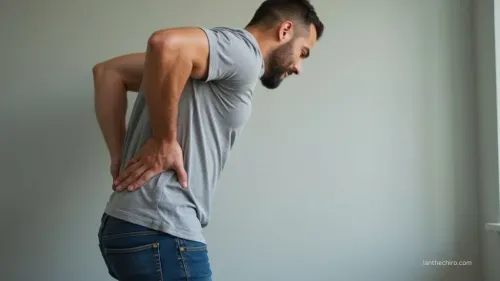Understanding Elbow Pain: Anatomy, Causes, Symptoms, and Treatment Modalities
Elbow pain isn't just a minor inconvenience; it's a sign that something's off in your musculoskeletal system. Whether you're a weekend warrior on the basketball court or chained to a 9-to-5 desk job, persistent discomfort in your elbow can be an indicator of underlying issues that warrant attention.
In this article, we'll dissect the essentials of elbow pain, from its root causes to the most effective treatment options.
Anatomy of the Elbow

Let's get a bit scholarly but keep it digestible. The elbow is a hinge joint, a biomechanical wonder that consists of three primary bones: the humerus in the upper arm and the radius and ulna in the forearm.
These skeletal components are interconnected and manipulated by a sophisticated combination of ligaments, tendons, and muscles. Dysfunction or damage to any of these constituents sets the stage for the onset of elbow pain.
Common Causes
Overuse
Repetitive motions like typing, lifting weights, or even incessant swiping on your smartphone can lead to overuse injuries. Over time, these activities can strain your elbow, causing discomfort or even chronic pain.
What causes elbow pain without injury?
You might think injury is the go-to culprit for elbow pain, but overuse from repetitive activities can be just as guilty. You don't need to have a dramatic accident to experience discomfort; sometimes, it's the subtle, ongoing strain that gets you e.g., typing on the keyboard & constant wringing of cloth.
Trauma

Accidents happen. Direct blows, falls, or sudden twists can result in sprains, strains, or fractures. Immediate medical attention is crucial to prevent long-term damage.
Medical Conditions
Conditions like arthritis, bursitis, and nerve compression aren't just fancy terms; they can be the culprits behind your elbow pain.
Complex Causes: A Research Perspective
Recent studies have shed light on the complexity of elbow pain. For instance, tennis elbow can have multiple underlying causes such as posterior interosseous nerve (PIN) entrapment and plica syndrome.
These conditions can co-exist, making diagnosis and treatment more challenging (Bonczar et al., 2023).
Symptoms to Watch For

How do I know if my elbow pain is serious?
It's time to sound the alarms when:
Sharp, shooting pain or a dull, persistent ache
Reduced range of motion or stiffness
Swelling, redness, or warmth around the elbow
Tingling or numbness, especially in the forearm & fingers
What does elbow tendonitis feel like?
Wondering about elbow tendonitis? You might actually be dealing with tendinosis, often mistaken in cases like tennis elbow (lateral tendinopathy) and golfer's elbow (medial tendinopathy). Unlike tendonitis, which is acute and inflammatory, tendinosis is a chronic condition.
Symptoms include a dull ache that intensifies when gripping or twisting, along with stiffness and weakness. Treatment focuses on long-term collagen repair, not just reducing inflammation (Stasinopoulos, 2020).
Diagnosis: The First Step to Relief

If you're struggling with persistent elbow pain, don't play doctor. Consult a healthcare professional for a comprehensive evaluation, which may include x-rays or MRIs.
Accurate diagnosis is the cornerstone of effective treatment, especially when multiple conditions could be at play (Bonczar et al., 2023).
Treatment Modalities
"How do you treat elbow pain?"
Well... You've got a good handful of options:
1. Therapeutic Exercises
Targeted exercises can fortify the muscles around your elbow, enhancing stability and mitigating pain.
2. Medication
Anti-inflammatory drugs can offer temporary relief, but remember, they treat the symptom, not the root cause.
3. Alternative Therapies
Options like acupuncture and chiropractic care provide non-invasive avenues for pain management.
Emerging Treatment Approaches
Recent research highlights the effectiveness of conservative approaches in treating tennis elbow. These include stretching exercises and proper techniques to prevent further injury (Chen et al., 2023).
Preventive Measures

Ergonomic Evaluation: Make sure your workspace is tailored to minimize strain on your elbow.
Regular Exercise: A well-rounded fitness regimen can go a long way in preventing elbow issues.
Rest and Recuperation: Never underestimate the healing power of good sleep and relaxation.
Final Thoughts
Elbow pain might seem trivial, but it can significantly impact your quality of life. Early intervention is key. Don't ignore the signs; seek professional guidance for a tailored treatment plan. And remember, prevention is always better than cure.
Stay tuned for our upcoming blogs on specific types of elbow pain, including Tennis Elbow and Golfer's Elbow, to get an even deeper understanding of this common ailment.
For more information on managing elbow pain or to schedule a consultation, feel free to contact us. Your health is our priority, and we're here to guide you every step of the way.
References
Bonczar, M., Ostrowski, P., Dziedzic, M., Kasprzyk, M., Obuchowicz, R., Zacharias, T., Marchewka, J., Walocha, J., & Koziej, M. (2023). Evaluation of lateral epicondylopathy, posterior interosseous nerve compression, and plica syndrome as co-existing causes of chronic tennis elbow. International Orthopaedics, 47(8), 1787–1795. https://doi.org/10.1007/s00264-023-05805-x
Wilson, J. J., & Best, T. M. (2005). Common overuse tendon problems: A review and recommendations for treatment. American Family Physician, 72(5), 811-818. PMID: 16156339.
Chen, D., Lin, Z., Liu, Y., & Zhou, H. (2023). Diagnosis, treatment, and prevention of tennis elbow. In Proceedings Volume 12611, Second International Conference on Biological Engineering and Medical Science (ICBioMed 2022) (pp. 1261138). Oxford, United Kingdom: International Conference on Biological Engineering and Medical Science. https://doi.org/10.1117/12.2669337













